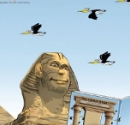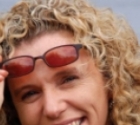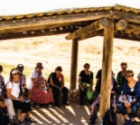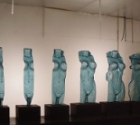
The old and new cathedrals, from across the Tormes River. Part of the old town of Salamanca can be seen behind them
The journey by bus from Madrid takes just over two hours. Our general direction is Salamanca, but we are aiming for the tremendous square (the Plaza Mayor) in the old town. This is the magnetic center which attracts not only the tourists, but the residents – notably the students. In our ignorance, we still don’t know that it is the end of the university year (the last days of May), which means the students are partying in force.
Building of the massive three-storey Plaza Mayor began in the eighteenth century. Palatial structures of yellow-gold stone enclose a tremendous open space which, among other things, was once used as a bull ring. Today, long, pillared arcades run along all four sides, easily accepting the thousands of visitors who sit in the arcades and in the square alongside the scores of cafes, restaurants and bars. The large groups of students who sit on the paved floor of the square are lost in the vastness of the space around them.
The main building at one end of the Plaza looks like a palace. In fact, the old town is one great display of the palaces of members of the Spanish nobility. And when you aren’t seeing palaces, you’re looking at churches, cathedrals or the ancient university buildings.
The great buildings are home to colonies of storks that build their outsize nests on the highest places which meddlesome human beings cannot reach. They feel quite at home, and we often stop to watch scenes of avian domesticity going on high above our heads.
It is late morning when we arrive and we wander around the small streets near the Plaza Mayor looking for a room. We find a hostel to our liking – the Sara Hostel, a few minutes walk from the square and next door to one of those aesthetic café/restaurants with great atmosphere.
This earliest of university towns in Spain was built mainly of great blocks of yellow-gold stone with brown and orange tints from Villamayor. Many of the buildings (notably the university, which was begun in the 13th century) have beautiful carvings and the artwork is referred to as Plateresque, the delicate carvings in the stone suggesting the type of work done by the “plateros”, or silversmiths.
The small roads which run around the Plaza are for pedestrians only, or at least that’s what we find as we wander down them past the great churches and buildings. Restaurants have tables and chairs lining one narrow road and we sit down among the students and some wedding guests. In another street, the entrance is totally blocked with tables and chairs.
While I like walking and looking at new places, this does not apply to museums. My wife, however, being a museum maven, goes into them wherever possible, and I follow. If you’ve ever seen a woman walking a reluctant puppy, you’ll have an idea of what I’m talking about.
In our erratic wanderings through small twisting streets, we stumble across several free museums and exhibitions. About fifteen minutes walk away from the hostel, near the House of the Conches (scallop shells), is the clock museum – La medida del tiempo. In a large hall some 200 timepieces of all shapes and sizes, many with elaborate moving figures and scenes and some with tremendous cogwheels, are ticking away and chiming in a sort of “time” symphony which has been playing for 200 years and more.
Just before we reach the lowest part of the old city – the river – we wander into two museums with blood-chilling exhibits. One contains photographs of Spaniards in the Nazi concentration camps mainly Mauthausen in Austria, during World War II. Of the 7,300 Spaniards who were interned there, 5,000 died, almost all of them between 1940 and 1942. A short film, which documents scenes of sadism and horror, is showing at intervals in a small hall. After a while I can’t take any more, and leave. There are very few people in the museum. One of them is an old woman. She stands without moving, as still as a statue, and watches the documentary. Yet another museum, not far from here, displays works by former prisoners, who recorded in paintings, sculptures and models what they had seen in Mauthausen.
For the next three days, we walk down streets and parks, in and out of churches, cathedrals and the university buildings. One day, we cross the Roman bridge (Puente Romano, built in the first century) to see modern Salamanca. From the other side of the Tormes River, we have a wonderful view of Salamanca’s two great cathedrals – the old and the new – built next to each other. The old cathedral is in the Romanesque style, from the twelfth century, while the newcomer built right next to it (they share a common wall) was completed by the early eighteenth century and is a mixture of styles ranging from Gothic through Baroque and Renaissance.
After some hours of walking among the trees and park areas along the river, we cross a bridge of more recent date, and return to the old city via the university buildings.
The first university building was constructed in the thirteenth century as an answer to the better-known universities of Oxford and Paris. Going up the steps to the entrance, we pick our way through crowds of students who are sitting on the steps, in the parks and on available open spaces.
Many of the university buildings have inner courtyards which are lined with pillars and have a grassy park area in the middle. They look like cloisters. The passages lead off into yet more halls and in one hall, we find an exhibition of gigantic photographs of landscapes from all parts of the world.
Quite by chance, we attend a Spanish wedding. The groom is an army man, and many of the men attending are dressed in highly-decorated army uniforms. Some of the women wear flouncy dresses, the bottom sections of which have yards of material, which narrow out from the waist up and taper off to almost nothing halfway or maybe a bit higher along the upper body, depending on how good your shoulders look.
At eight in the evening we attend a free concert given by the students (Coro de la Universidad de Salamanca) singing religious and traditional music a cappella, except for a drummer who sets the tempo. I wonder if, except for mothers, fathers and other family members, there are any other tourists there. It’s worthwhile going to the tourist office to study the roster of what’s on in town. (Sounds obvious, but for some reason – maybe we like freedom – we tend not to do this).
We return to the center of the old town. The Plaza Mayor is packed with young people and the roistering goes on until the small hours. A respectable slice of the 40,000 students have remained in town to celebrate. After all, they are on holiday!
Early one morning we see men hosing down the streets (the usual party-going signs are evident), while a pair of ladies equipped with brooms whisk away uncollected broken bottles, paper and so on. By the time the early risers of the town get going, the evidence of the night’s riotous behavior is gone. Everything is back to neat and clean, and Salamanca looks as beautiful as always.
After, as it were, drinking champagne day and night, we go off to Segovia, and here we manage to relax a little. If Salamanca is the champagne city, then Segovia is the town of a fine but modest wine. It’s a much smaller but steeper place. The Plaza Mayor is family size. A market is held there every Thursday, and the local band occasionally plays in the square.
We are lucky again with accommodation. After walking away from some hostels we looked at in dismay, we thought why not try a hotel. The hotel San Miguel, twenty meters away from the Plaza Mayor, turns out to be nicer, and even cheaper than the hostels we saw. Our balcony overlooks the narrow street and a corner of the San Miguel church where, a plaque informs us, Isabella was crowned queen of Castile and Leon in 1474. Every morning, when we look out of our window, the church clock lets us know exactly what time we woke up.
Segovia's buildings are on a gigantic scale. The Roman aqueduct, for one, towers over the deep and wide valley which runs down the center of the town. The aqueduct is a double-tiered structure measuring more than 28 meters at its highest point, and stretches across the valley and beyond for 818 meters. It is made up of tremendous blocks of white granite boulders piled on top of one another with nothing but weight and superior engineering holding them together. It has lasted for 2,000 years and looks as good today as it must have looked on the day it was built. And, what’s more, water still runs along it.
Then there is the Alcazar, dating from the eleventh century. The castle/fortress/palace, with Bavarian-type roofs, is perched on a tremendous sheer rock which overlooks one side of the valley around the old town. From the arched windows, we have magnificent views of small Spanish villages scattered amongst the flourishing green farmland stretching away to the horizon.
From the name, we already guess that this place was once an Arab stronghold. It was built over the remains of a Roman fortress and later added to by the Spanish conquerors. Today, it houses the general military archives of Spain; a wealth of large rooms display old carved furniture, pictures, ancient armour and weaponry.
In the steep valley below the Alcazar are the remains of what was once the Jewish cemetery – outside the city walls of course. To get to the so-called cemetery, we cross the valley and large park area and walk along a small path winding up a steep bank.
We find the cemetery – not graves as we know them but holes and elongated shapes carved in the bedrock. All that remains today are the holes. A sign informs us that this place once contained the Jewish dead of the town.
Segovia has an immense cathedral and an abundance of churches, palaces and convents. The Corpus Christi convent is housed in what was, until 1419, the main synagogue in the Jewish quarter. This building stood empty for more than 400 years, until it was partially destroyed by a fire in 1899. Inside the building, we see a photographic display of the gutted remains. After the fire the convent moved in. Except for the name – La Juderia – there is no sign of a Jewish quarter, but we read: ‘The city once had five synagogues, one of which still exists as the Corpus Christi Convent.’
We walk uphill through the old town, pass the large Church of Santisima Trinidad, and reach the highest point. Here, one side of the aqueduct meets up with the hilltop and ends in a great arch. The aqueduct stretches across the 300 meter wide valley and it is at the other end that we find hidden away in a convent and very discreetly advertised, a museum with traces of beautiful Mudéjar (Moorish influence) artwork – in ceilings, and amidst the other decorations, paintings on wood and artefacts. The museum also contains old and illuminated books.
They get very few visitors, the supervisor complains, and says that the tourist bureau does not advertise them. It’s a hot day outside, but inside the museum it is icy cold, and even though she is dressed warmly the woman is shivering. We are, of course, dressed for the hot outdoors, and after about half an hour we have to leave.
Segovia is an interesting place, and kept beautifully clean, but something that upsets me is the amount of litter, mainly paper, lying on the floor of the bars. Why should this be? I ask the woman in the tourist office off the main square near the aqueduct. “It’s the sign of a good bar,” she assures me.
 dear editor 159 magazine
dear editor 159 magazine OVERNIGHT OAT & SESAME BARS
OVERNIGHT OAT & SESAME BARS IN THE SWIM
IN THE SWIM From Bible to Bedouins and Battles
From Bible to Bedouins and Battles Trip to the Dead Sea
Trip to the Dead Sea Japan
Japan Mike Porter
Mike Porter